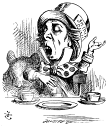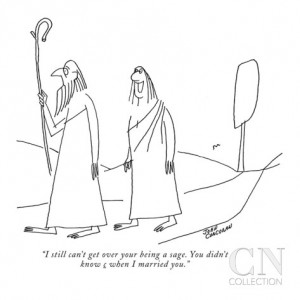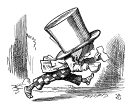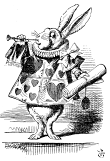Search us!
Search The Word Detective and our family of websites:
This is the easiest way to find a column on a particular word or phrase.
To search for a specific phrase, put it between quotation marks. (note: JavaScript must be turned on in your browser to view results.)
Ask a Question! Puzzled by Posh?
Confounded by Cattycorner?
Baffled by Balderdash?
Flummoxed by Flabbergast?
Perplexed by Pandemonium?
Nonplussed by... Nonplussed?
Annoyed by Alliteration?

Don't be shy!
Send in your question!
Columns from 1995 to 2006 are slowly being added to the above archives. For the moment, they can best be found by using the Search box at the top of this column.
 If you would like to be notified when each monthly update is posted here, sign up for our free email notification list.
If you would like to be notified when each monthly update is posted here, sign up for our free email notification list.
Trivia
All contents herein (except the illustrations, which are in the public domain) are Copyright © 1995-2020 Evan Morris & Kathy Wollard. Reproduction without written permission is prohibited, with the exception that teachers in public schools may duplicate and distribute the material here for classroom use.
Any typos found are yours to keep.
And remember, kids,
Semper Ubi Sub Ubi
|
Too bad. “Thrity” has a nice ring to it.
Dear Word Detective: I have been wondering about this since grade school: Why do we say “first” and “second,” which seem totally unrelated to the words “one” and “two”? “Third” at least somewhat resembles “three.” And the rest – fourth, fifth, sixth, etc. – pretty much just add “th” to the number. So why don’t we say “oneth,” “twoth,” and maybe “threeth”? — Rosemarie Eskes, Rochester, NY
That’s a good question, and there seem to be a lot of people out there on the internet asking the same thing. Unfortunately, the answers they’re getting at places like Yahoo Answers are, shall we say, not quite right. My favorite one confidently (but loonily) explains that “In most competitions, there is the importance of the first three rankers. It is possible that the words, first, second and third were coined for the first three winners. One having rank four was never recognized for prize distribution. So no special word was coined for rank 4 and so on.” I guess you could call this the State Fair Pie Contest theory. Remember, kids, losers don’t get a special word!
“First,” “second,” “third,” “fourth” and so on are called “ordinal numbers,” terms defining a thing’s place in a series (as opposed to “cardinal numbers,” such as “one,” “two,” “three,” etc.). The word “ordinal” comes from the Latin “ordo,” meaning “row or series,” which also gave us “order.” Ordinals can be used as nouns, pronouns or adjectives, and can be written either as words (“third”) or as numerals with suffixes approximating the sound of the word (1st, 2nd, 3rd, 4th, etc.).
The form of almost all English ordinals is regular, predictable and no mystery at all. Old English used the ending “tha” to form ordinals, which we retained in the form “th” (or “eth”) and use to cover everything from “fourth” to “five hundred billionth” and beyond. Just why the ordinals corresponding to “one,” “two” and “three” in English diverged from this pattern is unknown — stuff happens — but almost certainly had nothing to do with contests.
Our modern English word “first” was “fyrst” in Old English, and came from the Germanic root “furisto,” which was a superlative form of the root “fur,” meaning “before, preceding” (which also gave us “fore” and the prefix “for,” connoting “before” or “in front of”). So the sense of “first” was “absolutely before anything else.” As you might expect, “first” has acquired a range of extended meanings in various terms, such as “first aid” (medical aid delivered at the scene of injury) and “firsthand” (in “first person” experience, as opposed to “secondhand,” via another person).
To designate the thing that came immediately after the first thing, English originally simply used the word “other.” For obvious reasons, this use of “other” created confusion with all the, um, other uses of “other.” So around 1300, English borrowed “second” directly from French, which had derived it from the Latin “secundus,” meaning “following” or “next in a series” (also the source of our modern “sequel”).
“Third” came to us from the Germanic “thridda,” closely related to our “three,” which is why “third” and “three” seem similar. They’d be even more alike if a fairly common historical linguistic process called “metathesis” hadn’t reversed the “i” and “r” in “thrid” in the 16th century to make “third” (and led to the cardinals “thirteen,” “thirty,” etc., rather than “thridteen” or “thrity”).
Things are pretty straightforward from then on, with the exception of “eleventh” (“eleven” coming from the Old English “endleofan,” meaning “one left over, i.e., one more than, ten”) and “twelfth” (“twelve” being from the Old English “twelf,” literally “two left” over ten).
Unless, as Fat Freddy Freekowtski once explained about the turkey, “It was already stuffed.”
Dear Word Detective: I grew up hearing and using the word “jiblettes” for something small. For example, “There were jiblettes of paper all over the floor.” I’m not sure of the spelling, “jiblettes” or “jiblets,” we just used the word. I have never seen it written and cannot find it in a dictionary. — PJ Mahan.
That’s an interesting question, and it led me down a fairly weird path for a few minutes. You had, understandably, spelled the word in question “jiblette,” and that made me wonder, briefly, if it might be connected to “jib” (sail), perhaps likening those scraps of paper to tiny sails. I think I deserve five points for imagination on that one, but I’m glad the answer is much simpler. The word you’re seeking is “giblets,” which is pronounced “jiblets” (and in fact “jiblette” was a common spelling in the 18th century).
“Giblet” first appeared in English in the early 14th century, drawn from the Old French “gibelet,” meaning a stew made of game (related to the modern French “gibelotte,” rabbit stew). The initial meaning in English was “an inessential appendage,” and from there “giblet” moved on to mean “garbage” or “entrails.” By the 16th century “giblet,” usually in the plural form “giblets,” meant the entrails and other bits of a goose, turkey, etc., that are removed before cooking. This is the common meaning of “giblets” today, and turkeys raised in supermarkets usually have their “giblets” neatly tucked into a plastic bag and stowed inside for people who use them to make gravy, etc.
“Giblets” was also used in this “entrails” case in the same sense we use “guts” metaphorically today, i.e., to mean “courage or fortitude,” as well as more generally to mean “essence,” as in “to join giblets” meaning “to marry” (“If your ladyship’s not engaged, what’s the reason but we may join giblets without any pribble-prabble?” 1769).
All of these senses pretty clearly connect to the original “stew” sense of the French source, since entrails and such bits would make good ingredients for a stew. In the 17th century, however, a more general sense of “giblets” arose, this one meaning “odds and ends of little value,” “bits and pieces” or, applied to a person, “someone of little importance; a contemptible person” (“Oh fie upon ’em giblets!” 1638). This is almost certainly the same word as the “jiblettes” you remember being used to mean little scraps of “stuff.”
To boldly hit “print.”
Dear Word Detective: Recently, I got to wondering about the word “font.” There are several definitions, including a baptismal “font,” a typeface and someone, like yourself, a “font” of wisdom. I can accept that there might be some similarity between a baptismal font (water being splashed about generously) and a “font of wisdom” (wisdom being splashed about generously), but how do typefaces fit into the picture? Even more obscure, perhaps, is the word “fontanelle.” My sources suggest it comes from a similar source as the other meanings of font — i.e., a little spring. Ew. — Jim Brown.
“Font of wisdom”? OK, that got the cats snickering. When I was a kid, my mother framed a cartoon from the New Yorker and put it on the wall of the home office she shared with my father (who started this column in 1954). It showed a woman laughingly addressing her husband, a stereotypical bearded wise man in robes, saying “I still can’t get over your being a sage. You didn’t know beans when I married you.” (Interestingly, if you Google “beans sage cartoon,” you’ll find that the New Yorker is selling prints of that cartoon.)
Explaining how a baptismal “font” could possibly be related to the sort of “font” you use on your computer turns out, thankfully, to be unnecessary. There are actually two separate and completely unrelated “fonts” in English.
The typeface kind of “font” is the easier to explain. We use “font” loosely to mean a style of type (e.g., Comic Sans, the official Microsoft font), but, more precisely, a “font” is a complete set of a certain style of type, i.e., including a complete alphabet, punctuation, numerals, etc. This “font” first appeared in English in the late 16th century, based on the French “fonte,” from “fondre,” meaning “to cast” as one “casts” objects from molten metal. The first use of “font” in English was, in fact, to mean simply “cast iron.” Type at that time was, of course, cast from metal, but it wasn’t until the late 17th century that “font” (then often in the form “fount” or even “found”) was used in the “family of type” sense (“Break down the Printing-Presses, melt the Founds.” 1723).
“Font” in the other senses you mention is from a different source, the Latin “fons,” meaning “spring” or “fountain.” (“Fons” is also the ultimate source of “fountain.”) The earliest use of “font” in Old English was to mean a receptacle for water in a church used for baptism, etc. The form “fount,” which had the same source but is sometimes considered a different word, popped up in literary use in the 16th century with the meaning “spring, source” in both literal and figurative senses (“Ancient founts of inspiration well thro’ all my fancy yet.” Tennyson, 1842). This is the elusive “fount” or “font” of wisdom. As to which is correct in this sense, both are; although the poetic use of “fount” has made “fount of wisdom” more popular, “font” seems to be gaining on it in recent years.
“Fontanelle” comes directly from French, where it means literally “little fountain.” The most common uses of “fontanelle” are for the depression or hollow between two muscles or the areas of a baby’s skull that remain soft and flexible for the first year or so after birth. (The human skull is actually made up of six separate bones that fuse together over time.) The use of “fontanelle” for these spots (and the space between muscles) comes from the slight depression at such places, similar to a spring in a shallow hollow of the earth.
|
Makes a great gift! Click cover for more.  
400+ pages of science questions answered and explained for kids -- and adults!
FROM ALTOIDS TO ZIMA, by Evan Morris
 
|


 can be found
can be found 





Recent Comments